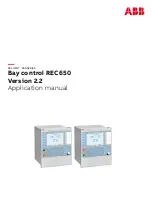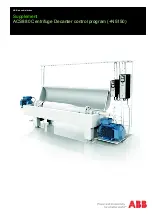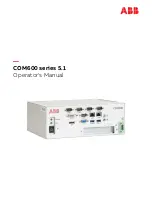
CON[2]=@COS[POS]*2
Assigns the second element of the array CON the cosine of the
variable POS multiplied by 2.
TIMER[1]=TIME
Assigns the first element of the array timer the returned
value of the TIME keyword.
Using a Variable to Address Array Elements
An array element number can also be a variable. This allows array entries to be assigned sequentially using a
counter.
Example:
#A
Begin Program
COUNT=0;DM POS[10]
Initialize counter and define array
#LOOP
Begin loop
WT 10
Wait 10 msec
POS[COUNT]=_TPX
Record position into array element
POS[COUNT]=
Report position
COUNT=COUNT+1
Increment counter
JP #LOOP,COUNT<10
Loop until 10 elements have been stored
EN
End Program
The above example records 10 position values at a rate of one value per 10 msec. The values are stored in an array
named POS. The variable, COUNT, is used to increment the array element counter. The above example can also be
executed with the automatic data capture feature described below.
Uploading and Downloading Arrays to On Board Memory
Arrays may be uploaded and downloaded using the QU and QD commands.
QU array[],start,end,delim
QD array[],start,end
where array is an array name such as A[].
start is the first element of array (default=0)
end is the last element of array (default=last element)
delim specifies whether the array data is separated by a comma (delim=1) or a carriage return
(delim=0).
The file is terminated using <control>Z, <control>Q, <control>D or \.
Automatic Data Capture into Arrays
The DMC-40x0 provides a special feature for automatic capture of data such as position, position error, inputs or
torque. This is useful for teaching motion trajectories or observing system performance. Up to eight types of data
can be captured and stored in eight arrays. The capture rate or time interval may be specified. Recording can done
as a one time event or as a circular continuous recording.
Command Summary - Automatic Data Capture
Command
Description
RA n[ ],m[ ],o[ ],p[ ]
Selects up to eight arrays for data capture. The arrays must be defined with the
DM command.
RD type1,type2,type3,type4
Selects the type of data to be recorded, where type1, type2, type3, and type 4
represent the various types of data (see table below). The order of data type is
important and corresponds with the order of n,m,o,p arrays in the RA command.
Chapter 7 Application Programming
•
155
DMC-40x0 User Manual
Содержание DMC-4040
Страница 17: ...DMC 4080 Layout Figure 2 2 Outline of the of the DMC 4080 DMC 40x0 User Manual Chapter 2 Getting Started 8...
Страница 19: ...DMC 4040 Dimensions Figure 2 5 Dimensions of DMC 4040 DMC 40x0 User Manual Chapter 2 Getting Started 10...
Страница 20: ...DMC 4080 Dimensions Figure 2 6 Dimensions of DMC 4080 Chapter 2 Getting Started 11 DMC 40x0 User Manual...
Страница 54: ...Chapter 3 Connecting Hardware 45 DMC 40x0 User Manual...
Страница 55: ...DMC 40x0 User Manual Chapter 3 Connecting Hardware 46...
Страница 56: ...Chapter 3 Connecting Hardware 47 DMC 40x0 User Manual...
Страница 73: ...Figure 4 1 GalilTools DMC 40x0 User Manual Chapter 4 Software Tools and Communication 64...
Страница 185: ...THIS PAGE LEFT BLANK INTENTIONALLY DMC 40x0 User Manual Chapter 7 Application Programming 176...
Страница 205: ...THIS PAGE LEFT BLANK INTENTIONALLY DMC 40x0 User Manual Chapter 10 Theory of Operation 196...
Страница 220: ...Step 2 Remove ICM For DMC 4040 Proceed to Step 3 Configure Circuit Appendices 211 DMC 40x0 User Manual...
Страница 222: ...Step 2 Remove ICM s Appendices 213 DMC 40x0 User Manual...
Страница 232: ...DMC 4080 Steps 4 and 5 Step 4 Replace ICM s Appendices 223 DMC 40x0 User Manual...
















































